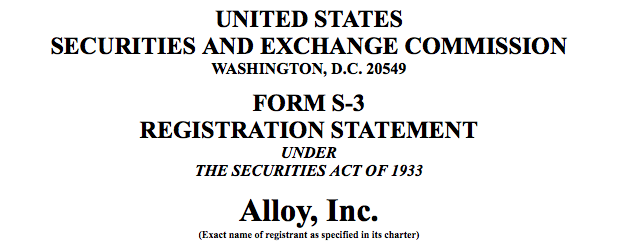A bad ten years for kiddie marketing firm Channel One News.
From Jim Metrock: In 2007, Alloy, Inc. issued 150,000 shares of stock in connection with its purchase of Frontline Marketing. [When a company issues stock it has to produce a SEC S-3 filing for the public.] Alloy paid $5.8 million for Frontline, which included $1.8 million of stock.
Alloy bought Frontline Marketing in April 2007. That same month they acquired Channel One News. There was no need for a S-3 with Channel One because there was no stock issued to pay for Channel One. In fact, there was no cash needed to pay for Channel One.
Unlike Frontline, a company that had value and produced a profit, Channel One had apparently zero or negative value and was losing money quarter after quarter. Alloy paid nothing – no cash, no stock – for Channel One. That’s an incredible situation. One can’t even say Alloy “bought” Channel One. Alloy simply took control of Channel One’s remaining assets and assumed some of the company’s liabilities.
Even though this S-3 report was issued because of its purchase of Frontline Marketing, Alloy, like all public companies, has to list the risks associated with its company so potential investors would be informed investors.
One big risk for Alloy shareholders and any future Alloy shareholders was the stink bomb company Alloy now owned: Channel One. Here is the part of the S-3 concerning Channel One:
__________________________________________________________________
If we are unable to restore Channel One to profitability, we may incur substantial write-offs.
When we acquired the assets of Channel One Communications Corporation (“Channel One”), Channel One was incurring significant losses due to a substantial reduction in revenue and a high cost structure. While we have taken steps to reduce Channel One’s costs, we cannot provide any assurances that we will be able to grow revenue to a level where it exceeds the costs of producing the programming. In addition, Channel One’s assets are very old and in need of replacement. Accordingly, we are planning on spending a significant amount of capital on upgrading Channel One’s infrastructure.
__________________________________________________________________
Alloy couldn’t do anything with Channel One and less than three years later unloaded the company on ZelnickMedia. ZelnickMedia didn’t want Channel One, but to get the rest of Alloy’s profitable companies they had to take Channel One.
ZelnickMedia couldn’t turn around Channel One, but they made a brilliant, if unethical and possibly illegal, move that breathed life into the failing in-school TV show. Faced with the massive costs of replacing the aging equipment which they had promised schools they would always keep up-to-date, ZelnickMedia wrote each school saying: Surprised, we are giving you all the Channel One equipment. We had title to the satellite dish, the headend units, and TV sets, but now your school owns it all. No need to thank us. We are just generous people. Enjoy.
That isn’t what they wrote (this is what they wrote), but they might as well. The cost of junking all the equipment would be more than Channel One could pay, so they shifted the cost to local school boards. This was never mentioned in Channel One contracts. As far as Obligation knows, no school has challenged Channel One on this cost transfer. So ZelnickMedia overnight eliminated a staggering cost facing Channel One.
Zelnick only kept Channel One for four years before turning it over to Houghton Mifflin Harcourt. HMH considered the acquisition of Channel One an “immaterial” transaction meaning they didn’t have to disclose how much they paid for Channel One – if they paid anything.


